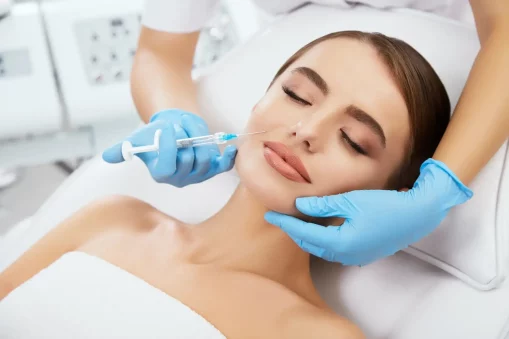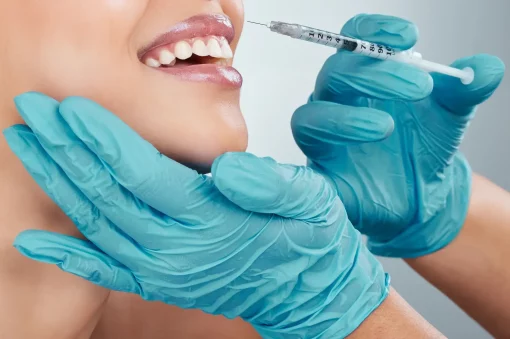Lip enhancement procedures have surged in popularity, changing how we enhance beauty and boost self-confidence. Hyaluronic acid (HA) fillers are the best-selling ones, with Restylane and Juvederm leading the market. These advanced products offer subtle yet impactful lip volume and shape augmentation, which was impossible 10 or 20 years ago.
So, understanding the nuances between Restylane vs Juvederm is crucial for every aesthetic clinic striving to provide top-tier treatments and consumers seeking reliable results. Both products are amazing, but each filler offers unique formulations tailored to different aesthetic needs.
In this guide, discover why Restylane and Juvederm have become market dominators and how they can elevate both your practice and personal beauty process.
Restylane Insight
Restylane is a premier line of hyaluronic acid (HA)- based dermal fillers produced by Galderma, a company renowned for its expertise in dermatology and aesthetic solutions.
Restylane’s gel formulation is stabilized using NASHA (Non-Animal Stabilized Hyaluronic Acid) technology. This technology, known for biocompatibility and longevity, is suitable for a wide range of aesthetic applications. The NASHA process involves fermenting bacterial HA and stabilizing it into a cohesive gel, which integrates smoothly into the skin and maintains its shape and volume over time.
Restylane offers various product variants:
- Restylane-L: Enhanced with lidocaine for improved patient comfort, this variant is ideal for moderate to severe facial wrinkles and folds.
- Restylane Lyft: Formerly known as Perlane, Lyft is designed for deeper injections, providing significant lift and volume to areas such as the cheeks and midface.
- Restylane Silk: Featuring smaller HA particles, Silk is perfect for precise lip enhancement and smoothing fine lines around the mouth.
Benefits of Restylane
Restylane offers several distinct advantages, making it a preferred choice for both patients and practitioners:
Natural-looking Results: The cohesive gel structure of Restylane allows it to integrate seamlessly into the tissue, providing a smooth and natural appearance. The HA used in Restylane mimics the body’s natural HA, which helps to retain moisture and elasticity in the skin.
Longevity: Clinical studies have demonstrated that the effects of Restylane can last up to 6-12 months, depending on the specific variant used and the individual’s metabolic rate.
Minimal Downtime: One key benefit of Restylane is the minimal downtime associated with the procedure. Patients can typically resume their normal activities immediately after treatment.
Drawbacks of Restylane
Despite its numerous benefits, there are always some drawbacks to consider when opting for Restylane treatments:
- Potential Side Effects: As with any injectable treatment, there are potential side effects. Common reactions include temporary swelling, bruising, and redness at the injection sites. These side effects are usually mild and resolve quickly. However, more severe reactions such as lumps, bumps, or allergies may occur in rare cases.
- Cost Considerations: The cost of Restylane treatments can be higher than that of other fillers due to the quality of the product and the longevity of the results. The initial investment is undoubtedly substantial, but the long-lasting effects often justify the cost for many patients.
- Outcome Depends on the Skill of Pratictioner: Achieving optimal results with Restylane requires high skill and expertise. The injector’s knowledge of facial anatomy, injection techniques, and product handling is crucial for ensuring natural and aesthetically pleasing outcomes. Poor technique can lead to uneven results, overfilling, or other complications, emphasizing the importance of choosing a qualified and experienced practitioner.
Overall, Restylane’s advanced formulation and proven efficacy make it a top choice for lip enhancement and other facial aesthetic treatments.
Exploring Juvederm
Juvederm’s primary component is hyaluronic acid (HA), and it is one of the most prominent lines of dermal fillers. Allergan manufactures this product.
What sets Juvederm apart is its use of proprietary cross-linking technologies, namely Hylacross and Vycross. These technologies enhance the durability and effectiveness of the HA gel.
- Hylacross Technology: Used in products like Juvederm Ultra and Juvederm Ultra Plus, Hylacross technology provides a smooth, malleable gel consistency that allows for even distribution within the skin. This technology ensures the filler maintains shape and provides a natural look and feel. Juvederm Ultra is ideal for moderate facial wrinkles and lip enhancements, while Juvederm Ultra Plus is designed for deeper folds and more substantial volume augmentation.
- Vycross Technology: For products like Juvederm Volbella, Vycross technology combines low and high molecular weight HA to create a more cohesive and long-lasting gel. This advanced cross-linking technology results in a smoother product that is easier to inject and provides a more natural appearance. Juvederm Volbella is tailored explicitly for subtle lip enhancement and smoothing of fine lines around the mouth, offering results that can last up to 12 months.
Benefits of Juvederm
Juvederm is famous for many benefits:
- Versatility: Juvederm’s extensive range of formulations allows for highly customized treatments. Whether addressing fine lines, deep facial folds, or enhancing lip volume, a Juvederm product is suited for each specific need.
- Smooth Consistency: The smooth gel consistency of Juvederm fillers
distributes evenly within the tissue. That’s where natural-looking results are coming from. The flexibility of the gel also makes it easy to mold and contour. - Predictable Outcome: High predictability contributes to high patient satisfaction, as the results are reliable and meet patient expectations. The uniformity in outcomes also instills confidence in practitioners, knowing they can achieve the desired aesthetic improvements.
Drawbacks of Juvederm
Despite its many advantages, Juvederm has certain drawbacks that should be considered:
- Possible Adverse Reactions: While Juvederm is generally well-tolerated, although rare, complications such as lumps, nodules, or asymmetry may occur. These issues often require corrective measures, including additional injections or, in some cases, hyaluronidase treatments to dissolve the filler.
- Higher Cost: The cost of Juvederm treatments can be higher compared to other fillers, the same as Restylane. This is partly due to the brand’s recognition and its proven efficacy.
- Expertise Requirement: Again, same as with Restylane, achieving optimal results with Juvederm hinges on the injector’s experience and familiarity with the specific products. An inexperienced injector might not achieve the desired results.
Restylane vs Juvederm – Comparative Analysis
Even though both have established reputations and are fantastic for lip enhancement, everyone must consider multiple factors — efficacy, safety, and patient satisfaction.
Efficacy
Clinical studies consistently show that Restylane and Juvederm deliver significant volume enhancement and contour refinement in lip augmentation.
- Volume Enhancement: Restylane’s NASHA technology provides a slightly firmer gel, giving more structured volume increases. Juvederm’s Vycross technology is a bit more natural.
- Longevity of Results: The longevity of results is similar. They usually last between 6 to 12 months, yet some studies suggest that Juvederm products have a slight edge in durability.
Safety Profile
The safety profiles of Restylane and Juvederm are exemplary. That is largely due to their primary ingredient, hyaluronic acid (HA), biocompatible and naturally occurring in the body.
- Common Side Effects: Both products have common side effects, including bruising, swelling, redness, and tenderness at the injection sites. These effects resolve within a few days with a proper aftercare.
- Adverse Reactions: Although rare, more serious adverse reactions can occur with both, such as lumps, nodules, or hypersensitivity reactions.
- Safety in Practice: Studies and clinical experience show that adherence to best practices significantly reduces the risk of complications.
Patient Satisfaction
High levels of patient satisfaction are common to both brands.
- Injector Expertise: An experienced injector can tailor the use of either Restylane or Juvederm to achieve the best possible results, enhancing patient satisfaction.
- Product Formulation: Patients often report preferences based on the feel of the product in their lips and the naturalness of the appearance. For example, some may prefer the firmer feel of Restylane for more defined enhancement, while others may favor the smoother consistency of Juvederm.
Also, managing patient expectations is crucial for satisfaction.
In Summary
Restylane and Juvederm stand out as gold standards, having extremely high success rates.
Restylane, with its cohesive gel structure and NASHA technology, excels in providing natural-looking volume and precise contouring. On the other hand, Juvederm’s advanced cross-linking technologies, such as Hylacross and Vycross, ensure smooth consistency and longer-lasting results.
Choosing Restylane vs Juvederm (or any other similar product) is not a one-size-fits-all decision. It requires careful consideration of various factors, including the specific aesthetic goals, the desired longevity of results, and any individual preferences or sensitivities. Clinical evidence supports the efficacy and safety of both products, so it’s highly unlikely that you will make a mistake if you are well informed.
Frequently Asked Questions (FAQ)
How do Restylane and Juvederm compare in terms of their sustainability and biodegradability?
Restylane and Juvederm are known for their biocompatibility and biodegradability. HA naturally breaks down in the body over time through enzymatic processes. However, Juvederm’s cross-linking technology, depending on the specific variant, can affect its rate of degradation compared to Restylane. Both products are considered safe and predictable in their breakdown within the skin tissues.
Can Restylane and Juvederm be combined in a single treatment session for enhanced lip augmentation?
Yes, Restylane and Juvederm can be combined in a single treatment session. This approach allows for targeting specific lip concerns such as volume enhancement and contour refinement simultaneously. It’s essential to ensure compatibility and optimize the blending of these fillers for natural-looking outcomes.
What are the main differences in post-treatment care protocols for patients undergoing Restylane vs Juvederm injections?
Post-treatment care protocols for Restylane and Juvederm injections typically include avoiding strenuous activity immediately after treatment, applying ice packs to reduce swelling, and avoiding excessive sun exposure. Specific differences may exist depending on the injector’s recommendations and the patient’s response to treatment. Both fillers require gentle handling and adherence to hygiene standards to minimize the risk of infection and optimize recovery.
How do the costs of long-term maintenance compare between Restylane and Juvederm for lip enhancement?
The costs of long-term maintenance for Restylane and Juvederm depend on factors such as the specific product variants used, the frequency of touch-up treatments, and the individual’s metabolism. Generally, Juvederm may have a slightly higher initial cost due to its proprietary cross-linking technology and brand recognition, while Restylane’s pricing can vary based on the clinic and injector expertise.
What are the potential risks associated with repeated treatments of Restylane versus Juvederm over time?
Potential risks associated with repeated treatments of Restylane and Juvederm include temporary swelling, bruising, redness at the injection site, and rare instances of allergic reactions. Long-term risks are minimal due to HA’s natural biodegradation process within the body.
Can Restylane and Juvederm be used interchangeably in other facial areas aside from lip enhancements?
Yes, they are suitable for various facial areas beyond lip enhancements. They can effectively address nasolabial folds, marionette lines, and cheek volume loss. Tailoring the choice of filler to specific facial regions and aesthetic goals ensures harmonious facial rejuvenation and natural-looking results. Consultation with a skilled injector helps determine the most appropriate filler and technique for each treatment area.
References
Yazdanparast T, Samadi A, Hasanzadeh H, Nasrollahi SA, Firooz A, Kashani MN. Assessment of the Efficacy and Safety of Hyaluronic Acid Gel Injection in the Restoration of Fullness of the Upper Lips. J Cutan Aesthet Surg. 2017 Apr-Jun;10(2):101-105. doi: 10.4103/JCAS.JCAS_115_16. PMID: 28852297; PMCID: PMC5561704.
Stéphane S, Candice SM, Florence B. “Bi-Bi” technique for lip augmentation: A retrospective study on 30 cases. J Cosmet Dermatol. 2022 Oct;21(10):4339-4344. doi: 10.1111/jocd.15221. Epub 2022 Jul 19. PMID: 35810347; PMCID: PMC9796850.



0 Comments